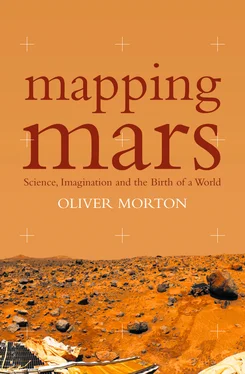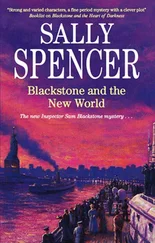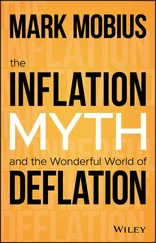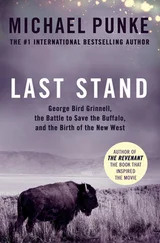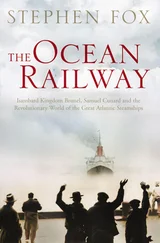But the earth, partly because of those submarine-hiding oceans, could never be mapped in its entirety in the way that Mars was. Nor could it be mapped with such supreme disinterest. Earthly maps are heavy with duties to property and strategy, duties which can warp and distort them. On Mars everywhere was alike; nowhere was rich, or strategic, or owned, and so a pure disinterest reigned. There was a political point in their publication – these were American products, based on American ingenuity, printed by the American government – but in the images themselves there was nothing but the data, the interpretation and the artist’s style.
Though they were in some sense less faithful to the truth of the planet than the television images they were based on, the maps were far more approachable, especially for the layperson. * They had a feeling of naturalism that the other forms the data were presented in lacked. Like most naturalism, this was highly contrived, depending on a number of strict conventions. Tricks of shading were used to make sure the users’ eyes saw craters as dimples, not domes (an inside-out illusion endemic in photographs of planetary surfaces). The regional differences in the surface’s albedo – the curves and blotches which are all that you can ever see of Mars through any earthly telescope – were suppressed. Mars’s albedo was controlled not by the nature of its surface features but by the way the wind blew dust around and over them (the dusty bits were bright – the bits swept clear were darker), and winds were not something the mapping project was interested in. Inge developed a clever way of making separate albedo plates so that the maps could be printed with regional patterns or without, but after a few quadrangles the effort was given up. Nor was the colour on the final prints – a soft, light-brownish pink – the real colour of Mars. It was a colour chosen by Inge just to give a feeling of Mars. And somehow it did. The maps are indeed, as Inge always insists, technical documents that happen to have been drawn up in pictures, not words. But they were something more, too. After the maps were made, the real Mars was not only a surface under the spacecraft’s circling cameras. It was also something directly available to, and through, human minds and eyes and hands.
Sadly, mapping Mars descended from being a delight to being a chore. Almost as soon as the first series of one to 5 million maps was finished, it was decided to revise them using new pictures taken by the Viking orbiters which had reached the planet in 1976. The original artwork was pulled out of storage and reworked on the basis of the new data. Because the control net had evolved, features had moved a bit and fudges had to be made. New detail was added, but in some cases the resulting maps looked cluttered and confusing. Inge was no longer checking the presses and the colours became less subtle. Frictions between Inge and Batson took their toll. Bridges retired in 1990; Inge left in 1994 and became embroiled in litigation with the Survey on the basis that his medical condition was unreasonably used to prevent his re-employment in 1997.
The airbrush artists were not replaced. Batson saw that new computer systems could make photomosaics ever more maplike – the Mars Digital Image Mosaic 1:2 million series he oversaw the creation of is now the basic reference for almost everyone who studies the Martian surface. The topographic mapping of the planets is now almost entirely a matter of image processing. This has not banished beauty. In the late 1980s a geologist named Alfred McEwen produced some magnificent views of large reaches of the planet on the computer while at Flagstaff. An image he made of the western hemisphere – the ridge of Tharsis volcanoes close to the limb, the gash of Valles Marineris across the centre, the thin trace of Echus Chasma running thousands of kilometres towards the north like a gold highlight – may be more widely circulated than any other picture of the planet. It is to Mars what Harrison Schmitt’s endlessly reproduced picture of east Africa, the Indian Ocean and Antarctica, taken during the Apollo 17 mission, is to the earth. But though they can be beautiful and highly accurate – on such work you can improve things pixel by pixel if need be – the computer images lack the intimacy of the airbrush. By 2000 the late-comer Aeschliman was the only old airbrush hand remaining at the Survey’s Flagstaff branch and he was doing his work entirely on screen. There is still an airbrush on the premises somewhere, but there is no longer any compressed nitrogen to bring it to life.
The maps themselves, scarred by revisions, sit in storage. All, that is, except one. Late in 1972, according to Jurrie van der Woude, who looked after some of the logistics of the Mariner 9 pictures and has been doing similar things at JPL ever since, Bruce Murray pleaded for a copy of the one-sheet shaded relief map of the whole planet that Batson’s team was making based on the Mariner data. Van der Woude called Batson in Flagstaff, who admitted that Inge and Bridges had finished the map. Plates of it were being made for reproduction. When it was released it would turn out to be big news – a page of its own in the New York Times , a British tabloid headline screaming ‘American Miracle – Map of Mars!’. But it was not yet released. Indeed, there were not yet any printed copies.
Van der Woude persisted; eventually Batson agreed to send the original over to Pasadena, as long as it came back swiftly. Van der Woude gave it to Murray with dire imprecations that it must, but must, be returned in two days. Three days later van der Woude started to think that the normally friendly Murray was avoiding him.
It took a week or so for van der Woude to corner Murray and find out what had happened. Murray was an ambitious man; within a few years he would be the director of JPL. He had wanted the map to impress Harold Brown – then president of Caltech, later secretary of Defense. Brown had thought the map wonderful and asked to show it to a guest, Henry Kissinger. Kissinger, too, was impressed and commandeered the map in order to offer it as a gift to Leonid Brezhnev; in part, we can be sure, because the Soviet Union’s two missions to Mars in 1971 had failed, their pre-programming too rigid to allow diem to sit out the dust storm in orbit before getting to work, as Mariner 9 had done. And so the map had gone to the Kremlin. *
At least that’s Jurrie van der Woude’s story. Inge remembers that the map was lost, but not how. Murray says he remembers nothing of it – as does Harold Brown. Kissinger has proved elusive on the matter. So I have to doubt it. But I want it to be true. I want the first modern map of that planet to have played a role, even just a small one, in the history of this one. I want it to have reached the top. And I want it to have ended up where Jurrie says he last saw it, glimpsed in the background during a televised interview with a Russian space scientist, apparently taking pride of place on his office wall. I want it to be somewhere where it gets treated as an icon.
* There were exceptions. Experience on the moon had led the mappers to treat odd features as craters until proved otherwise, so some Martian oddities ended up drawn as craters even when they weren’t. One of these non-crater craters went on to feature as a landmark in a rather good science fiction novel, Paul McAuley’s The Secret of Life.
* It’s a nice coincidence that the father of astronomical art, Chesley Bonestell, was also much drawn to Chinese landscapes and delighted in being able to produce good enough examples of the genre to fool his friend Ansel Adams into accepting them as genuine.
* The other great cartographic products of the Mariner 9 mission, a set of ten-foot globes made at JPL through the painstaking hand-positioning of fragments of images on spherical surfaces, have a strange patchwork texture that makes them almost impossible for anyone but an expert to interpret.
Читать дальше
